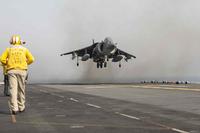I’m working my way through CSBA president Andrew Krepinevich’s latest on a new war fighting concept (.pdf) under development called “AirSea Battle.” The concept is intended to ensure Navy and Air Force power projection against China’s rapidly growing arsenal of what the military terms anti-access weapons, such as aircraft carrier killing ballistic missiles, stealthy cruise missiles, stealthy submarines, dense air-defense networks, anti-satellite and cyber war weaponry.
AirSea Battle is focused on China, with Iran as the lesser included case. Krepinevich’s paper titled “Why AirSea Battle?” sets out to answer just that question. A follow-on report promises to flesh out the actual concept. I haven’t read the whole thing yet, but what I’ve read so far is familiar territory, mostly details about new and more long-range precision weapons and their implications for U.S. forces in the Pacific.
Krepinevich and CSBA have written a lot about China’s growing military power, which is understandable, as the CSBA team is heavily influenced by the research priorities of Pentagon futurist Andy Marshall, who has long warned of the rise of China.
Krepinevich writes that China’s burgeoning anti-access arsenal is intended to, “raise the US cost of power-projection operations in the Western Pacific to prohibitive levels, thereby deterring any American effort to meet its defense obligations to allies in the region while setting the conditions for a potential latter-day Chinese Greater East Asia Co-Prosperity Sphere of influence.”
I think it’s obvious that as our strategic focus during the 20th century was Europe, and although in the last decade the Middle East, for the 21st century it will be Asia. It’s important to remember that there are actually two rising powers in Asia, China, of course and India; there is every chance that India’s economy may pass China in the next decade.
I see the value in developing the AirSea Battle concept as it focuses the services on a specific strategic and operational challenge. But I also worry that it focuses the services on too specific a challenge. It continues the process of “benchmarking” two thirds of the U.S. military against a single opponent, that being China.
I hope somebody is thinking through the implications of that benchmarking on a military that will, in all likelihood, never fight China. If we learned anything in Iraq and Afghanistan, it’s that a military brilliantly configured to fight the Red Army was not the right military to battle shadowy insurgent networks. We do know potential enemies will continue to come up with ways to fight in ways that exploit our military weaknesses, not our strengths.
The other thing that concerns me is that while the big brains in this town are thinking about the war fighting concepts to battle China, not enough are thinking about how to compete strategically against China on the economic and political field of battle, the field China prefers.
China is flexing its economic muscle globally: buying huge swaths of farmland in Africa, building deep water ports in Asia, colossal gas pipelines, rail lines across the Himalaya and of course a big mine in Afghanistan.
Yes, China is engaged in a military buildup. If I were Chinese, I would consider it criminal if my government didn’t build up its military to protect vital raw material flows across the seas and was able to protect the approaches to the homeland.
However, if the challenge is China using its impressive and growing economic muscle to establish what Krepinevich calls the “Chinese Greater East Asia Co-Prosperity Sphere of influence,” I’m not sure a military solution is the right response. That’s a political-economic challenge, not a military one.
Anyway, something to think about and I welcome learned comments to the contrary. I’ll write more about AirSea Battle as the concept gets fleshed out.
A reminder: the Pentagon’s annual report on the Chinese military is due out next month.
-- Greg








